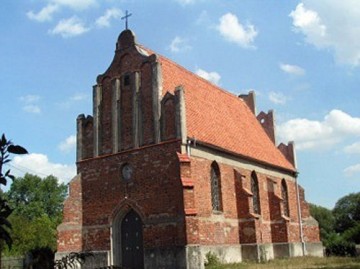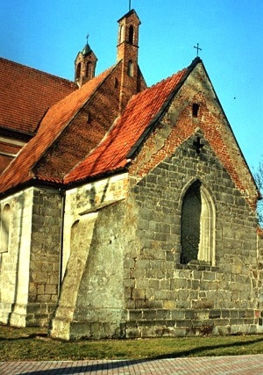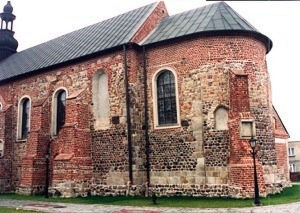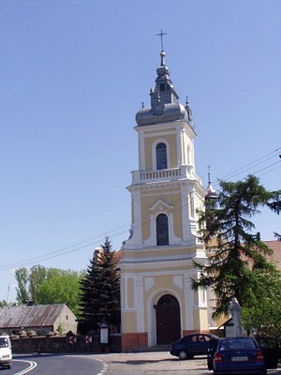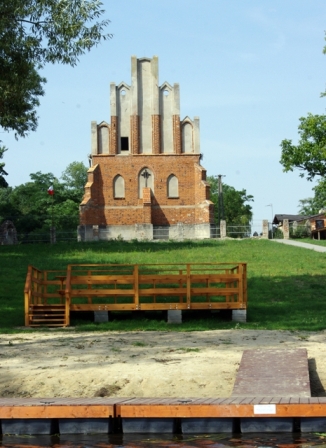
The monuments within the Konin district, located along an important communication route connecting Kalisz and Konin with the Piast Route (No. 25), form an interesting complex of buildings that can serve as an educational supplement to the trail. These include primarily Romanesque churches in Stare Miasto and Kazimierz. Among this group, we can also mention the Gothic church in Warzymów, in the Skulsk commune, a town strongly associated with the Bloody Devil from Venice (died 1400). This is also the legendary place where Piast Kołodziej (from Warzymowo) and his wife Rzepicha (Goplana) were born.
The Polish history of the Piast dynasty is reflected in other monuments of cultural heritage, including churches in Stare Miasto, Kościelec Kolski, Kazimierz Biskupi, penitential crosses from Konin and Licheń, as well as a milepost from Konin. These monuments are part of the Romanesque Trail and the legacy of the Five Martyr Brothers, alongside a few notable Gothic structures. The historic past of the Konin district is filled with events related to the Piast monarchy, legends, and traditions that preserve the memory of Polish statehood. This includes the tradition of the Five Martyr Brothers (1003), the creation of the Lublin bishopric (around 1130), the foundation of the Ląd monastery (1145, refounded in 1195-1196), the Teutonic expeditions against Konin, Kalisz, and Uniejów (1131-1132), the Polish-Teutonic process (the Warsaw Process, 1139), and the civil war of 1382-1385. The people of the Konin district played a significant role in the establishment of the Jagiellonian University and marked their presence in wars, politics, diplomacy, culture, and science. The first chancellor of the renovated University – Piotr Wysz, bishop of Kraków (died 1414) – came from Radolina.
There is also a legend associated with the Marian sanctuary in Skulsk, about the miraculous vision experienced by Bolesław the Brave’s team, who saw the Holy Mother. Additionally, the so-called Budzisław Apocrypha, which recounts the ancient tradition of Andrew Świeradz—one of the first hermits venerated at the Tropie on the Dunajec River—relates to Budzisław Kościelny. The life of Andrew Świeradz dates back to the late 15th century. The legend of Andrew Świeradz was written in the chronicles of the Benedictine monks from Kazimierz. From here, the cult spread to Kujawy (Lubraniec).
Piast Trail and Its Monuments:
While visiting the Konin district, tourists will deepen their knowledge of the Piast Trail and Poland during the 10th to 14th centuries. They will also learn about the connections between this region and the clergy of the cathedral chapters in Gniezno and Poznań, Benedictine monasteries in Mogilno, regular canons in Trzemeszno, Norbertine Sisters in Strzelno, the collegiate church in Kruszwica, and the most prominent monuments along the most widely known Polish educational route—the Piast Trail. On this trail, one will also encounter historical figures associated with the Konin district or those who worked here. Among them is Wojciech Miliński, abbot of Trzemeszno and friend of the Bernardine monks from Kazimierz, known from his tombstone at the former monastic church in Kazimierz. His successor, Michał Kościesza Kosmowski, was connected with the Bieniszew monastery. Magnificent epitaphs of mitred bishops in the Holy Trinity Basilica in Strzelno commemorate Sierakowski, a priest from Mąkolno. The Jaskólski mitred family came from the Rychwał area. Priest Łuczyński was closely associated with the monastery in Kazimierz. The Norbertine Sisters from the Strzelno convent were part of St. Anna’s Brotherhood at the Bernardine monastery in Kazimierz, and the Bernardine monks served as their confessors for almost 200 years. Metropolitan canons from Gniezno, who were vicars of the St. Bartholomew parish church (and at the same time of Stare Miasto near Konin), were also connected to Konin.
One of the most famous branches of the Zaremba family originates from Królików. The ancestors of Wojciech Zaremba, subchancellor of Poland (second half of the 15th century), settled in Żychlin. Wincenty Kot, archbishop of Gniezno and tutor to the sons of King Władysław Jagiełło, was connected with Kleczew.
The history of the Konin district can be found in the records of hundreds of places across Wielkopolska. Its influence is visible on Wawel Hill—in the cathedral, in Warsaw, Poznań, and even in many places across Europe.
Jan Długosz and the Konin Region:
Reading the Annals by Jan Długosz, one of the most significant chronicles of medieval Europe, reminds us of the milestone from Konin (1153), the alleged foundations made by Piotr Dunin (Kazimierz Biskupi, Konin), and towns that belonged to monasteries in Trzemeszno and Strzelno. The first book of this masterpiece, Chorography, describes in detail many towns in the Konin district, water regions related to Gopło, and numerous rivers. Therefore, it is not surprising that the interests of the historian are precisely reflected in his work. This is likely due to Sędziwój of Czechło, the provost of the regular canons in nearby Kłodawa, who made his extensive collection of sources available to Jan Długosz.
The Route of the Piast Trail:
- Kruszwica (collegiate church, castle tower)
- Skulsk (Holy Mother sanctuary)
- Warzymowo (fortified settlement, Gothic church)
- Noć
- Kazimierz Biskupi (St. Martin Romanesque church)
- Konin-Gosławice (church, castle)
- Konin (medieval parish church, milepost)
- Stare Miasto (church)
- Dzierzbin (Romanesque church)
- Kościelec Kaliski (Romanesque church)
- Kalisz-Zawodzie (fortified settlement, site of the former St. Paul collegiate, Franciscan monastery, St. Nicholas church, collegiate church of the Blessed Virgin Mary)
Prepared by Paulina Wojtyniak







